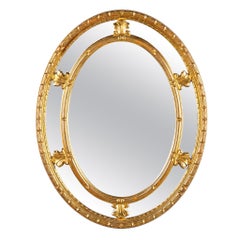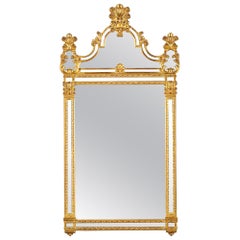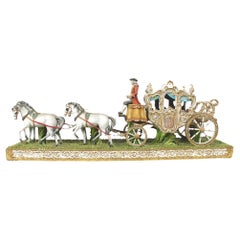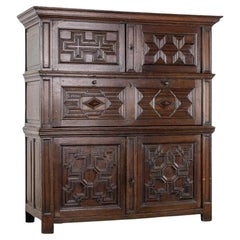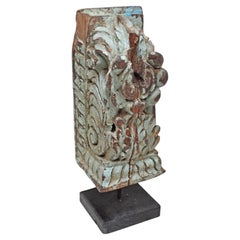Old World Wonders
to
2
35
27
24
18
17
9
8
8
7
6
6
5
4
4
3
3
2
2
2
2
1
1
1
1
1
1
1
1
1
1
3
1
1
Large vintage oval Neo-Classical style gilt framed mirror by Deknudt
By Deknudt
Located in Leesburg, VA
Large vintage oval Neo-Classical style gilt framed mirror by Deknudt
Deknudt
Deerlijk, Belgium; 20th century
Glass, distressed glass gilt frame
Approximate size: 36.25 (h) x 28.25...
Category
Late 20th Century Belgian Neoclassical Wall Mirrors
Materials
Glass
Large and exquisite Louis XVI style gilt framed mirror by Deknudt
By Deknudt
Located in Leesburg, VA
Large and exquisite Louis XVI style gilt framed mirror by Deknudt
Deknudt
Deerlijk, Belgium; 20th century
Glass, distressed glass gilt frame
Approximate size: 49.25 (h) x 23.6 (w)...
Category
Late 20th Century Belgian Louis XVI Wall Mirrors
Materials
Glass
Rare Vintage Monumental Porcelain Horse Drawn Victorian Carriage centerpiece
By Capodimonte
Located in Leesburg, VA
Rare Vintage Monumental Porcelain Horse Drawn Victorian Carriage centerpiece group
Capodimonte Porcelain, after a model by Giorgio Galletti
Naples, Italy; second half of the 20th century
Porcelain
Approximate size: 37 (w) x 15 (h) x 10 (d) in.
This beautiful and elaborately detailed porcelain group features an ornately modeled carriage drawn by four horses. The coach features a driver seated on his perch wearing a tricorn hat and a lovely lady is seated in the coach box wearing a light blue dress with intricate gesticulating openwork porcelain lace...
Category
Late 20th Century Italian Late Victorian Figurative Sculptures
Materials
Porcelain
An impressive early 18th century Dutch oak geometric kussen cabinet with integra
Located in Leesburg, VA
An impressive early 18th century Dutch oak geometric kussen cabinet with integral secretaire
Anonymous
Belgium or Southwestern Netherlands; probably first quarter of the 18th centur...
Category
Antique Early 18th Century Belgian Baroque Wardrobes and Armoires
Materials
Brass
A large Elephant's Snout Volute shell - Cymbium glans gamelan
Located in Leesburg, VA
A large Elephant's Snout Volute shell - Cymbium glans gamelan
Approximate size: 12 (l) x 5.5 (w) x 4 (h) in.
The Elephant’s Snout Volute shell is a species of sea snail belonging t...
Category
Early 20th Century Unknown Other Natural Specimens
Materials
Shell
Original Hand-Carved South Asian Antique Architectural Bracket Fragment
Located in Leesburg, VA
Original Hand-Carved South Asian Antique Architectural Bracket Fragment for display
Anonymous
Probably India; early-to-mid 20th century
Wood
Approximate size: 4.2 x 3.8 x 12 in.
A...
Category
Early 20th Century Indian Anglo-Indian Mounted Objects
Materials
Wood, Paint
Pair of finely engraved gilt brass European Gothic Revival pricket candlesticks
Located in Leesburg, VA
Pair of finely engraved gilt brass European Gothic Revival pricket candlesticks
Anonymous
Europe; 19th century
Gilt Brass
Approximate size: 17 (h) x 5 (w) x 4.5 (d) in.
This pai...
Category
Antique Late 19th Century Belgian Gothic Revival Candlesticks
Materials
Brass
Pair of gilt brass European Gothic Revival pricket candlesticks
Located in Leesburg, VA
Pair of gilt brass European Gothic Revival pricket candlesticks
Anonymous
Europe; probably early 20th century
Gilt Brass
Approximate size: 22 (h) x 6 (w) x 5 (d) in.
This pair of...
Category
Early 20th Century Belgian Gothic Revival Candlesticks
Materials
Brass
A tall gilt brass European Gothic Revival pricket candlestick
Located in Leesburg, VA
A tall gilt brass European Gothic Revival pricket candlestick
Anonymous
Europe; first-half 20th century
Gilt Brass
Approximate size: 29 (h) x 6 (w) x 6 (d) in.
A tall gilt brass E...
Category
Early 20th Century Belgian Gothic Revival Candlesticks
Materials
Brass
Pair of tiered gilt brass European Gothic Revival pricket candlesticks with Solo
Located in Leesburg, VA
Pair of tiered gilt brass European Gothic Revival pricket candlesticks with Solomonic spiraling stems
Anonymous
Europe; probably ca. 1900
Gilt Brass
Approximate size: 23 (h) x 6 (...
Category
Antique Early 1900s Belgian Gothic Revival Candlesticks
Materials
Brass
Antique Hand-Carved Architectural Wooden and White Polychrome Floral Carving
Located in Leesburg, VA
Antique Hand-Carved Architectural Wooden and White Polychrome Floral Carving
Anonymous
Probably South Asia; mid-20th century
Wood
Approximate size: 12.8 x 2.28 x 6.8 in.
A South A...
Category
Mid-20th Century Rustic Mounted Objects
Materials
Wood
Antique Hand-Carved Architectural Wooden Floral Motif Panel with White Polychrom
Located in Leesburg, VA
Antique Hand-Carved Architectural Wooden Floral Motif Panel with White Polychrome
Anonymous
Probably South Asia; mid-20th century
Wood
Approximate size: 9.8 x 2 x 6.4 in.
A South ...
Category
Mid-20th Century Indian Bohemian Mounted Objects
Materials
Wood
Collection of 3 South Asian Antique Architectural Fragments on Stands
Located in Leesburg, VA
Collection of 3 South Asian Antique Architectural Fragments on Stands
Anonymous
Southern Asia, probably India; first-half of the 20th c...
Category
Early 20th Century Indian Archaistic Sculptures and Carvings
Materials
Wood
An antique 18th century Walnut European Santos - Saint figure on a plinth
Located in Leesburg, VA
An antique 18th century Walnut Figural Statue of Saint Peter on a plinth
Anonymous
Northern Europe, probably Belgium; first-half of the 18th century
Walnut
Approximate size: 17 (h) x 4.25 (w) x 4.25 (d) in.
The present sculpture, perfectly suited for a curiosity cabinet or English-European country styled home, was likely realized for a church side chapel or choir stall niche. The serious look of the saint’s face...
Category
Antique Early 18th Century Belgian Baroque Figurative Sculptures
Materials
Walnut
Stunning Pair of 7-candle Gothic Revival Brass Candelabra
Located in Leesburg, VA
Stunning Pair of 7-candle Gothic Revival Brass Candelabra
Anonymous
Europe; 19th century
Brass or bronze
Approximate size: 13 (h) x 21 (w) x 4 (d) in.
This pair of European bras...
Category
Antique Late 19th Century Belgian Gothic Revival Candelabras
Materials
Brass
Electrified Antique Vintage Wood and Brass Kerosene Lamp with notable provenance
Located in Leesburg, VA
Anonymous
Early 20th century; North America
Wood, brass
Approximate size: 26 (h) x 9 (w) x 9 (d) in.
The present lamp, formerly a kerosene lamp, has been converted to an electrical...
Category
Antique Early 1900s American Late Victorian Table Lamps
Materials
Brass
Distinctive pair of 19th century Empire Style gilt metal candelabras
Located in Leesburg, VA
Anonymous
19th century; European
Gilt bronze and metal
Approximate size: 17.75 (h) x 9.75 (w) x 3.5 (d) inches
The present pair of distinctive antique gilt metal candlesticks are i...
Category
Antique 19th Century French Empire Candelabras
Materials
Brass
Victorian or Edwardian Pair of Silver Desert Cutlery Pieces
Located in Leesburg, VA
Henry Pope
1890; Birmingham, England
Silver (925/1000) and mother-of-pearl
Approximate size: 7.5 (l) x 1 (w) x .15 (d) inches
Active in Birmingham, England, Henry Pope was a prolif...
Category
Antique Late 19th Century English Edwardian Sterling Silver
Materials
Silver
Pair of large masculine Art Nouveau Bronze and Wood Wall Plaque Sconces
Located in Leesburg, VA
Anonymous
Early 20th century; European
Bronze and wood
Approximate size: 24 (h) x 14.5 (w) x 10.25 (d) inches
The present pair of handsome sconces are the perfect addition to a mood-driven library, office or study. Burnished bronze shades, with an open-work border treatment, cover a pair of candlestick...
Category
Early 20th Century Italian Art Nouveau Wall Lights and Sconces
Materials
Bronze
A Rustic European 18th century French faience fountain with spigot
Located in Leesburg, VA
Anonymous
Mid-18th century; probably Moustiers or Nevers, France
Faience and brass
Approximate size: 12.25 (h) x 9 (w) x 6.25 (d) inches
The present dispenser was either used as a water or wine cooler or possibly for washing hands. The original lid is lost-to-time, yet its provincial beauty remains attractive and sublime. The present example—baked with white enamel and decorated with a lovely hand-painted polychrome lattice and floral theme—is warm, elegant and rustic. The curving linear form of the flowers subtly recall the influence of Japan’s Kakiemon style present in France during the Rococo period yet is still indebted to the earlier influence of Italy’s prolific maiolica workshops.
This fountain would serve as an elegant addition for display on an oak or distressed wood console table...
Category
Antique 18th Century French Rustic Jars
Materials
Faience, Porcelain
Rare and important painted bronze Crucifix after a model by Michelangelo
By Michelangelo Buonarroti
Located in Leesburg, VA
A rare and very fine bronze corpus of Christ after a model by Michelangelo, cast ca. 1597-1600 by Juan Bautista Franconio and painted in 1600 by Francisco Pacheco in Seville, Spain.
The present corpus reproduces a model attributed to Michelangelo. The best known example, lesser in quality, is one on display at the Metropolitan Museum of Art (MET).
The association of this corpus with Michelangelo was first brought to light by Manuel Gomez-Moreno (1930-33) who studied the wider circulated casts identified throughout Spain. The attribution to Michelangelo was subsequently followed by John Goldsmith-Phillips (1937) of the MET and again by Michelangelo expert, Charles de Tolnay (1960).
While Michelangelo is best known for his monumental works, there are four documented crucifixes he made. The best known example is the large-scale wooden crucifix for the Church of Santa Maria del Santo Spirito in Florence, made in 1492 as a gift for the Prior, Giovanni di Lap Bicchiellini, for allowing him to study the anatomy of corpses at the hospital there. In 1562, Michelangelo wrote two letters to his nephew, Lionardo, indicating his intention to carve a wooden crucifix for him. In 1563 a letter between Lionardo and the Italian sculptor Tiberio Calcagni, mentions this same crucifix (a sketch of a corpus on the verso of a sheet depicting Michelangelo’s designs for St. Peter’s Basillica [Palais des Beaux-Arts in Lille] may reproduce this). That Michelangelo was working on small corpora in the last years of his life is further evidenced by the small (26.5 cm) unfinished wooden crucifix located at the Casa Buonarroti, considered his last known sculptural undertaking. Michelangelo’s contemporary biographer, Giorgio Vasari additionally cites that Michelangelo, in his later years, made a small crucifix for his friend, Menighella, as a gift.
Surviving sketches also indicate Michelangelo’s study of this subject throughout his career, most notably during the end of his life but also during the 1530s-40s as he deepened his spiritual roots. The occasional cameo of crucified Christ’s throughout his sketched oeuvre have made it challenging for scholars to link such sketches to any documented commissions of importance. All the while, in consideration that such objects were made as gifts, it is unlikely they should be linked with commissions.
Nonetheless, a number of theories concerning Michelangelo’s sketches of Christ crucified have been proposed and some may regard the origin of the present sculpture. It has been suggested that the corpus could have its impetus with Michelangelo’s work on the Medici Chapel, whose exclusive design was given to the master. It is sensible smaller details, like an altar cross, could have fallen under his responsibility (see for example British Museum, Inv. 1859,0625.552). Others have noted the possibility of an unrealized large marble Crucifixion group which never came to fruition but whose marble blocks had been measured according to a sheet at the Casa Buonarroti.
A unique suggestion is that Michelangelo could have made the crucifix for Vittoria Colonna, of whom he was exceedingly fond and with whom he exchanged gifts along with mutual spiritual proclivities. In particular, Vittoria had an interest in the life of St. Bridget, whose vision of Christ closely resembles our sculpture, most notably with Christ’s proper-left leg and foot crossed over his right, an iconography that is incredibly scarce for crucifixes. The suggestion could add sense to Benedetto Varchi’s comment that Michelangelo made a sculpted “nude Christ…he gave to the most divine Marchesa of Pescara (Vittoria Colonna).”
Of that same period, two sketches can be visually linked to our sculpture. Tolnay relates it to a sketch of a Crucified Christ at the Teylers Museum (Inv. A034) of which Paul Joannides comments on its quality as suggestive of preparations for a sculptural work. Joannides also calls attention to a related drawing attributed to Raffaello da Montelupo copying what is believed to be a lost sketch by Michelangelo. Its relationship with our sculpture is apparent. Montelupo, a pupil of Michelangelo’s, returned to Rome to serve him in 1541, assisting with the continued work on the tomb of Pope Julius II, suggesting again an origin for the corpus ca. 1540.
The earliest firm date that can be given to the present corpus is 1574 where it appears as a rather crudely conceived Crucifixion panel, flanked by two mourners in low-relief and integrally cast for use as the bronze tabernacle door to a ciborium now located at the Church of San Lorenzo in Padula. Etched in wax residue on the back of the door is the date, 27 January 1574, indicating the corpus would have at least been available as a model by late 1573.
The Padula tabernacle was completed by Michelangelo’s assistant, Jacopo del Duca and likely has its origins with Michelangelo’s uncompleted tabernacle for the Basilica of St. Mary of the Angels in Rome.
The impetus for the Padula tabernacle’s Crucifixion panel begins with a series of late Crucifixion sketches by Michelangelo, depicting a scene of Christ crucified and flanked by two mourners (see British Museum Inv. 1895.0915.510; Ashmolean Museum Inv. 1846.89, KP II 343 recto; Windsor Castle RCIN 912761 recto; and Louvre Inv. 700). A faintly traced block possibly intended for sculpting the sketch of the crucified Christ on its recto was discovered by Tolnay on a version of the composition at Windsor Castle. The Windsor sketch and those related to it appear to have served as preparatory designs for what was probably intended to become the Basilica of St. Mary’s tabernacle door. Vasari documents that the project was to be designed by Michelangelo and cast by his assistant, Jacopo del Duca. Michelangelo died before the commission was complete, though on 15 March 1565, Jacopo writes to Michelangelo’s nephew stating, “I have started making the bronze tabernacle, depending on the model of his that was in Rome, already almost half complete.” Various circumstances interrupted the completion of the tabernacle, though its concept is later revitalized by Jacopo during preparations to sell a tabernacle, after Michelangelo’s designs, to Spain for Madrid’s El Escorial almost a decade later. The El Escorial tabernacle likewise encountered problems and was aborted but Jacopo successfully sold it shortly thereafter to the Carthusians of Padula.
An etched date, 30 May 1572, along the base of the Padula tabernacle indicates its framework was already cast by then. A 1573 summary of the tabernacle also describes the original format for the door and relief panels, intended to be square in dimension. However, a last minute decision to heighten them was abruptly made during Jacopo’s negotiations to sell the tabernacle to King Phillip II of Spain. Shortly thereafter the commission was aborted. Philippe Malgouyres notes that the Padula tabernacle’s final state is a mixed product of the original design intended for Spain’s El Escorial, recycling various parts that had already been cast and adding new quickly finished elements for its sale to Padula, explaining its unusually discordant quality, particularly as concerns the crudeness of the door and relief panels which were clearly made later (by January 1574).
Apart from his own admission in letters to Spain, it is apparent, however, that Jacopo relied upon his deceased master’s designs while hastily realizing the Padula panels. If Michelangelo had already earlier conceived a crucifix model, and Jacopo had access to that model, its logical he could have hastily employed it for incorporation on the door panel to the tabernacle. It is worth noting some modifications he made to the model, extending Christ’s arms further up in order to fit them into the scale of the panel and further lowering his chin to his chest in order to instill physiognomic congruence. A crude panel of the Deposition also follows after Michelangelo’s late sketches and is likewise known by examples thought to be modifications by Jacopo based upon Michelangelo’s initial sculptural conception (see Malgouyres: La Deposition du Christ de Jacopo del Duca, chef-d’oeuvre posthume de Michel-Ange).
Jacopo’s appropriation of an original model by Michelangelo for more than one relief on the Padula tabernacle adds further indication that the crucifix was not an object unique to Jacopo’s hand, as few scholars have posited, but rather belongs to Michelangelo’s original...
Category
Antique 16th Century Renaissance Figurative Sculptures
Materials
Bronze
18th century Polychrome and Giltwood Angel from the ambit of Franz Ignaz Gunther
Located in Leesburg, VA
A large polychrome and gilt limewood sculpture of an Angel in the Manner of Franz Ignaz Gunther, ca. 1770, Munich (Bavaria)
Approximate size: 107 c...
Category
Antique Mid-18th Century German Rococo Wall-mounted Sculptures
Materials
Wood
An early 18th century Florentine Ebonized Wood Aedicule Case
Located in Leesburg, VA
An early 18th century Florentine ebonized wood aedicule case with gilt metal embellishments
Ambit of Leonard van der Vinne
Possibly first decade of the 18th century; Florence, Italy
Approximate size: 83.5 (h) x 69 (w) x 23 (d) cm
The cabinet’s centralized glass door is flanked by thick spiraling Solomonic columns surmounting a lower drawer. To the rear of the cabinet, the motif repeats in an eloquent display of perspectival treatment. The overall work is supported by a tiered base, elegantly conceived, and the cabinet is topped by a handsome pediment flanked by square plinths crested by gilt metal finials and an openwork frieze.
The cabinet’s tempered and moderate form suggests an origin probably during the first decade or quarter of the 18th century. Although utilitarian in concept, the reserved and sublime expressiveness of this cabinet is managed with a quality and care respective of the influence of Florentine ebony cabinetry work conceived in the Galleria dei lavori or Grand Ducal Workshops of the 18th century Medici dynasty. In particular, its base mouldings echo a remarkable Night Clock...
Category
Antique Early 18th Century Italian Baroque Vitrines
Materials
Brass
Antique Silverplated Fox-themed Inkwell by James Deakin & Sons, England
By James Deakin & Sons
Located in Leesburg, VA
James Deakin & Sons Ltd.
Sheffield, England; ca. 1897-1935
Silver plated copper and glass
Approximate size: 11 (w) x 6 (h) x 6 (d) in.
This lovely silver-plated inkwell features an...
Category
Early 20th Century English Victorian Inkwells
Materials
Silver, Copper, Silver Plate
Oriental Wool Area Rug by Rex & Rex inspired by the Rococo Singerie genre
Located in Leesburg, VA
Distinctive Oriental Wool Area Rug by Rex & Rex inspired by the Rococo Singerie genre
Rex and Rex
21st cent.; designed in Palm Beach, FL; handmade in China
Wool
Approximate size: ...
Category
20th Century American Rococo Chinese and East Asian Rugs
Materials
Wool
Decorative Pair of Wooden Light Green and Gold Painted Architectural Finials
Located in Leesburg, VA
Decorative Pair of Wooden Light Green and Gold painted Architectural finials
Anonymous
Probably ate 19th or early 20th century; American in the European style
Painted and gilded pine wood
Approximate size: 18 x 6 in.
The present pair of decorative painted wood architectural finials...
Category
20th Century American Neoclassical Revival Architectural Elements
Materials
Pine
18th Century Neo-Classical Italian Carved, Painted and Gilt Wall Panel
Located in Leesburg, VA
Anonymous
ca. 1790; Italy
Wood panel and plaster, painted, gilt and lacquered
Approximate size: 118.5 x 82.5 x 5 cm
The present panel is probably of late 18th century origin,...
Category
Antique Late 18th Century Italian Neoclassical Wall-mounted Sculptures
Materials
Wood, Giltwood
Pair of Late 17th Century Giltwood Spanish Altarpiece Elements
Located in Leesburg, VA
The present pair of late 17th century or early 18th century Spanish Baroque giltwood architectural elements may have once formed part of an altarpiece environment. Their decorative p...
Category
Antique Late 17th Century Wall-mounted Sculptures
Materials
Giltwood
$1,496 Sale Price
25% Off
